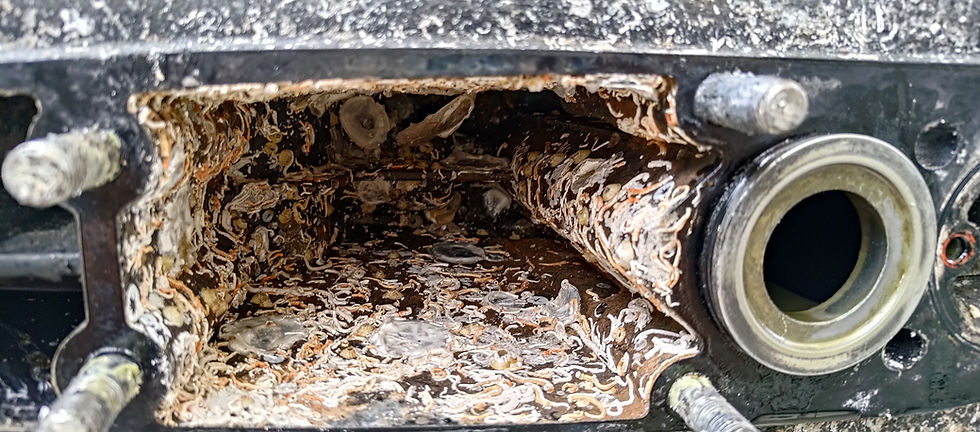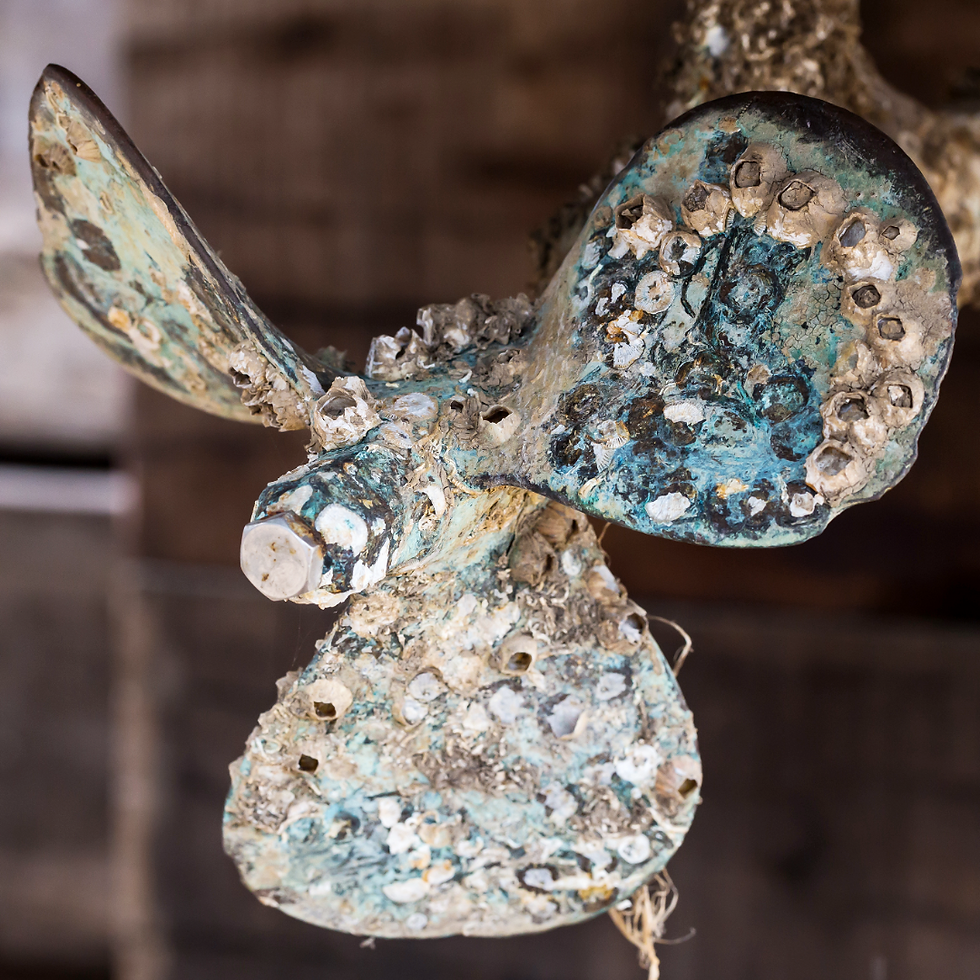Understanding How Marine Growth Affects Boat Performance in South Florida
- Felicia Lambert
- Jul 17
- 5 min read

Boating in South Florida’s beautiful water—especially along the Treasure Coast and around Jensen Beach—can be one of life’s greatest pleasures. However, with the beauty of the ocean comes a challenge every boat owner should be aware of: marine growth. Organisms like algae, barnacles, and mollusks can quickly attach to your boat's hull and underwater components, compromising performance, safety, and efficiency.
In this Tech Tips edition, we’ll explore how marine growth affects your vessel, where it tends to form, and how to manage it effectively, allowing you to enjoy smoother, safer trips on the water.
Keep reading to learn more about:
What Is Marine Growth?

Marine growth is when aquatic organisms stick and grow on your boat’s surfaces, mainly the hull, while it is in the water. These organisms thrive in warm, nutrient-rich waters, like those in South Florida. Even a thin layer of marine growth can harm your boat's performance.
Common Types of Marine Growth:
Algae: Are you seeing streaks of green or brown sticking to your hull? These are usually the first signs of marine growth. A boat docked in a still marina can develop noticeable algae within just a few weeks.
Barnacles: These crustaceans attach firmly to surfaces for survival, but they significantly increase drag. Even a single barnacle can generate drag a hundred times its own weight.
Mussels: You will often see these bivalve mollusks grow in clusters, adding weight to your boat and further increasing resistance in the water. Left unchecked, mussels can add up to 70 pounds of extra load over a season.
These growths don’t just make your boat look neglected—they directly affect performance, fuel economy, and handling.
Performance Impacts of Marine Growth
1. Increased Drag
Drag is the resistance a boat experiences as it moves through the water, and it is one of the biggest consequences of marine growth. Your hull should be smooth, but as it becomes rough with marine growth, water resistance increases, forcing your engine to work harder. Research shows that even light marine buildup can raise fuel consumption by up to 20%. That’s an extra $20 on every $100 fill-up—just from a slightly fouled hull.
2. Added Weight and Balance Disruption
Marine organisms don’t just cling to your boat's submerged surfaces—they accumulate. Over time, this added weight shifts your boat’s balance. A 20% increase in hull weight can impact buoyancy, steering, and overall stability, increasing the risk of taking on water or poor handling in rougher seas.
3. Reduced Maneuverability
While navigating Florida's lively waters, swift turns and precise steering are crucial. Marine growth can decrease a boat's maneuverability by as much as 30%, complicating the ability to dodge obstacles or dock smoothly. This diminished agility endangers safety, particularly during urgent maneuvers or in busy waterways.
Where Marine Growth Tends to Accumulate
Marine growth doesn’t affect your boat evenly—it targets specific areas that offer the right conditions for attachment and growth. Understanding these vulnerable zones can help you stay ahead with preventive maintenance.
Common Problem Areas:
Hull (Below the Waterline): The hull is the most obvious and extensive target for marine growth. Constant exposure to seawater and sunlight makes it a prime location for algae, barnacles, and mussels. Flat-bottomed boats and boats with textured paint may see growth even faster.
Propeller and Rudder: Despite their motion in the ocean, these parts often accumulate marine growth like barnacles and algae, especially in boats that remain idle for long stretches. A few barnacles on your prop blades can drastically reduce your propulsion efficiency and increase vibration.
Trim Tabs: Often overlooked, these components are frequently submerged and offer the perfect flat surfaces for marine growth. Barnacles here can interfere with boat trimming and handling.
Intake Grates and Water Ports: Algae and mollusks can clog your cooling system intakes or livewell ports, potentially leading to overheating or reduced system performance.
Skeg and Keel: These structural components provide additional surface area for organisms to attach, adding drag and sometimes leading to corrosion if unchecked.
Lower Unit (Outboard or Sterndrive Engines): Perhaps one of the most vulnerable and overlooked areas, the lower unit of your motor is frequently submerged and often sees heavy barnacle buildup. If not regularly cleaned and protected with anti-fouling measures, barnacles can encrust this entire section, blocking your water intakes, damaging seals, and interfering with propeller operation. It’s not uncommon for boaters to pull their vessel out of the water only to find the lower unit completely riddled with hard growth, requiring hours of scraping or even replacement parts.
Bilge and Transom: Although your bilge and transom are not always submerged, stagnant water and humidity in these areas can encourage slime, mold, and algae formation, especially in neglected boats or those stored in humid marinas.
How to Manage and Prevent Marine Growth
Regular Cleaning and Maintenance
Routine hull cleanings are essential. Many South Florida boaters schedule monthly cleanings, especially during the warmer months when growth accelerates. Hiring a professional diver or boat cleaning service ensures thorough maintenance without damaging your boat’s finish.
Use of Anti-Fouling Paint
Applying anti-fouling paint at the start of the season provides a protective barrier that deters marine organisms. These coatings, often containing biocides, can reduce fuel costs by as much as 15% when maintained properly. Choose products suited to local water conditions and consider eco-friendly formulas to minimize environmental impact.
Smart Docking Choices
If you need to dock your boat at a marina, look for one with strong currents and cleaner water. These conditions typically result in less marine growth compared to areas with stagnant, warmer water. If you can, choose docking locations that encourage circulation and water movement.
Environmental Considerations
While anti-fouling solutions are effective, some contain chemicals that can leach into surrounding waters, affecting marine ecosystems. You can opt for environmentally responsible alternatives, such as non-toxic or biodegradable coatings, which offer a balance between protection and sustainability. Boaters should aim to minimize harm while still defending their vessels.
Signs Your Boat May Be Affected by Marine Growth
Watch for these early indicators of marine growth:
A green film or slime along the hull
White, rough patches—these are often barnacle colonies
Slower-than-usual speeds or increased fuel use
A rough feel when you run your hand along the submerged hull
Catching these signs early can save you from bigger repairs and performance issues later.
Final Thoughts: Stay Ahead of Marine Growth
Understanding what marine growth is and addressing it right away is essential to keeping your boat in top shape. Whether you're cruising the calm waters of Jensen Beach or heading offshore, regular maintenance ensures you will have a smoother, safer ride. With consistent cleaning, smart docking habits, and eco-friendly practices, you can preserve your boat’s performance and extend its lifespan.
Owning a boat in Jensen Beach is a privilege—maintaining it shouldn’t be a burden. That’s why we offer a convenient monthly maintenance plan designed to help you stay ahead of marine growth and protect your investment year-round.
Don’t let marine growth slow you down. Sign up for our monthly maintenance plan today and enjoy smooth sailing, every time you hit the water.














Comments